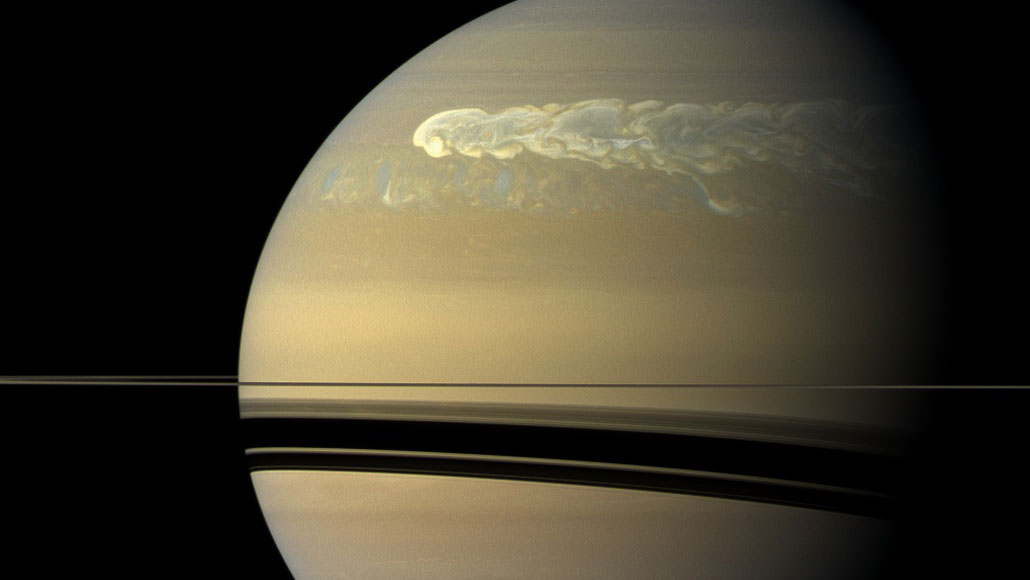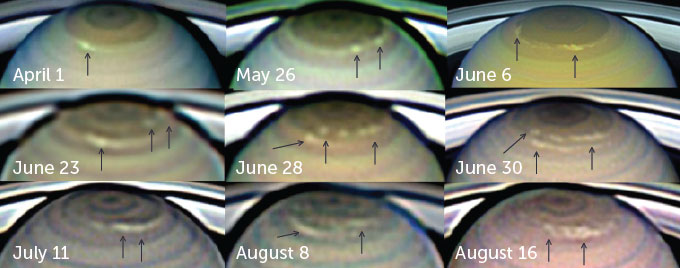Astronomers have spotted a new type of storm on Saturn
The tempests are larger than other squalls but smaller than massive Great White Spots

Until now, astronomers have only seen Saturn ravaged by small storms that last days or enormous Great White Spots that last months (a Great White Spot that raged in 2010 and 2011 pictured). Now, astronomers have identified a third, midsize kind of storm activity on the gas giant.
JPL-Caltech/NASA, SSI
- More than 2 years ago
Saturn saw some weird weather last year.
Telescope images have revealed a newfound type of storm activity that raged near Saturn’s North Pole in 2018, researchers report online October 21 in Nature Astronomy.
Until now, astronomers had seen only two kinds of Saturnian storms: relatively small storms about 2,000 kilometers across that appear as bright clouds for a few days and Great White Spots that are 10 times as large and last for months (SN: 4/14/15). The newly spotted weather disturbance was a series of four midsize storms. Each was several thousand kilometers across and lasted between about 1.5 weeks and about seven months.
Saturnian storms are thought to originate in water clouds hundreds of kilometers below the planet’s visible upper cloud cover. Studying such storms can offer a window into deep atmospheric goings-on that aren’t directly observable, says Agustín Sánchez-Lavega, who studies planetary atmospheres at the University of the Basque Country in Bilbao, Spain.
Sánchez-Lavega and colleagues analyzed hundreds of telescope images taken by amateur astronomers, as well as pictures from the Calar Alto Observatory in Spain and NASA’s Hubble Space Telescope. From late March to late October 2018, four unusual bright spots appeared in Saturn’s atmosphere near the North Pole, between the latitudes of 67° N and 74° N.
Computer simulations indicate that each midsize storm required about 10 times as much energy as a small storm to get going, but only about one-hundredth the energy required to brew up a Great White Spot.
Weather report
In 2018, telescopes on the ground and in space spotted a series of storms near Saturn’s North Pole (white spots indicated by black arrows). Not all of the storms were visible simultaneously; the shortest-lived lasted about 10 days while the longest-running storm raged for 214 days. These weather disturbances were larger than storms previously seen on the gas giant, but nowhere near as big as Saturn’s rare Great White Spots.
Tracking a new type of storm activity on Saturn, April 1–August 16, 2018

The sighting of this storm outbreak “almost leaves more questions than it can give answers,” says Georg Fischer, a planetary scientist at the Space Research Institute of the Austrian Academy of Sciences in Graz not involved in the work.
For instance, the 2018 telescope images don’t show whether the newfound storms crackled with lightning. Small storms typically boast a few flashes per minute and Great White Spots several flashes per second. If similar midsize storms appear in the future, Fischer says, radio telescopes that monitor the gas giant’s tempests for lightning strikes could indicate whether middling storms are more similar to their small or giant counterparts. That might help scientists figure out how they form.
The timing of the 2018 storm sequence hints that it might have been a failed Great White Spot. These planetary-scale storms have been observed only six times since 1876. But those few data points seem to indicate that Great White Spots form around the same latitudes once every 60 years or so. The last time Saturn sported a far-north Great White Spot, near the latitudes where the 2018 storm quartet cropped up, was in 1960.
It’s possible that a 2010 Great White Spot that formed farther south siphoned so much energy from Saturn’s atmosphere that there was only enough left to fuel a few middling storms, rather than a full-blown Great White Spot in 2018, Sánchez-Lavega says.
But planetary scientist Robert West, who wasn’t involved in the study, is skeptical that the 2010 Great White Spot could have interfered with storm activity farther north. That’s because gas swirling in Saturn’s atmosphere at different latitudes tends to stay in its own lane. West, of Caltech and NASA’s Jet Propulsion Laboratory in Pasadena, Calif., suspects that the storm sequence in 2018 was not a failed Great White Spot, but “a whole different thing.” For now, however, the origins of those intermediate storms and how they relate to other weather phenomena on Saturn are still mysterious, he says.







